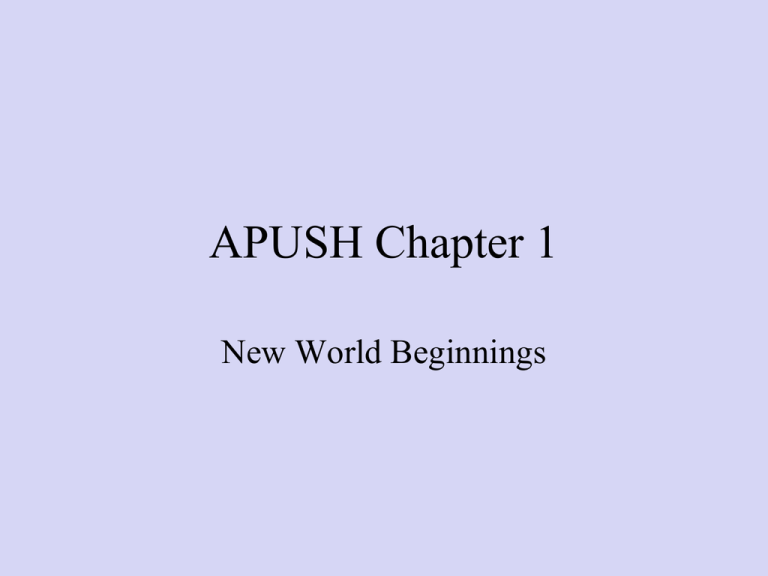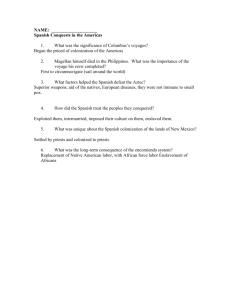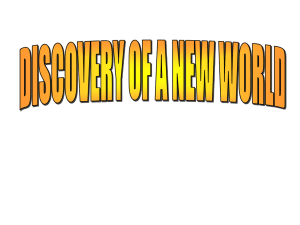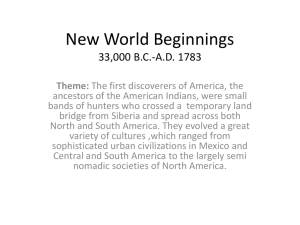Chapter 1 PowerPoint - Jessamine County Schools
advertisement

APUSH Chapter 1 New World Beginnings •PreColumbian time period. •First Americans came from Asia •Crossed the Bering Strait during the Ice Age •Following a food source •Gradual migration Culture area WHITE EUROPEANS •Used the land for economic needs •Clearing the land, destroying hunting areas and fencing it off into private property •Divided the land and selling it for monetary value. NATIVE AMERICANS •Relationship with environment as part of their religion •Need to hunt for survival •Ownership meant access to the things the land produced, not ownership of the land itself. European movement Earlier Explorations 1. Islam & the Spice Trade Silk Road 2. New Player Europe Marco Polo Expansion becomes a state enterprise monarchs had the authority & the resources. Better seaworthy ships. Motives for European Exploration 1. Crusades by-pass intermediaries to get to Asia. 2. Renaissance curiosity about other lands and peoples. 3. Reformation refugees & missionaries. 4. Monarchs seeking new sources of revenue. 5. Technological advances. 6. Fame and fortune. European trade routes Direct Causes = 3 G’s • Political: Become a world power through gaining wealth and land. (GLORY) • Economic: Search for new trade routes with direct access to Asian/African luxury goods would enrich individuals and their nations (GOLD) • Religious: spread Christianity and weaken Middle Eastern Muslims. (GOD) The 3 motives reinforce each other Treasures from the Americas! EFFECTS •Europeans reach and settle Americas •Expanded knowledge of world geography •Growth of trade, mercantilism and capitalism •Indian conflicts over land and impact of disease on Indian populations •Introduction of the institution of slavery •Columbian Exchange explorers European Colonization European Colonization • Once the New World is discovered, the Big 4 four European countries begin competing for control of North America and the world…. – Spain – England – France – Portugal • This power struggle ultimately leads to several wars. F/I War 1750 • Spanish first to pursue colonization • Start in Caribbean, then Central and South America—most important was conquest of Aztecs by Cortez (1521) and Incas by Pizzaro (1531) • First permanent colonies in what will become United States are founded by Spain – St. Augustine (Florida) is founded (1565) to protect Spanish treasure fleets Explorers Sailing For Spain • Columbus - Italian sailing for Spain Landed in the “West Indies” - 1492 • Magellan - Portuguese sailing for Spain - 1st to circumnavigate the world - 1522 Spanish Exploration Columbus Balboa Pizzaro De Leon Cortes De Soto Coronado Vespucci Spanish empire by the 1600’s consisted of the part of North America Central America Caribbean Islands Much of South America. •Spanish soldiers who came to the New World to help conquer and settle the Americas for Spain. •Some of their methods were harsh and brutal especially to the Native American population. •With every Spanish explorer were conquistadors and members of the Catholic Church to convert Native Americans. First Spanish Conquests: The Aztecs Cortes conquered Aztec Empire in 1519 and took control of modern day Mexico. vs. Hernando Cortés Montezuma II First Spanish Conquests: The Incas Pizarro conquered Incan Empire in modern day Peru in 1532 vs. Francisco Pizarro Atahualpa Cycle of Conquest & Colonization Explorers European Colonial Empire Permanent Settlers The Colonial Class System Peninsulares Spanish ancestory Mestizos Spanish and Indian mixture Native Indians Creoles Spanish and Black mixture. Mulattos White American and Black mixture Black Slaves The Influence of the Colonial Catholic Church Our Lady of Guadalupe Guadalajara Cathedral Spanish Mission Father Bartolomé de Las Casas •Believed Native Americans had been treated harshly by the Spanish. •Indians could be educated and converted to Christianized. •Believed Indian culture was advanced as European but in different ways. 1. Spanish practice of securing an adequate and cheap labor supply = FEUDALISM •“granted” to deserving subjects of the King 2. Conquistador controlled Indian populations •Required Indians to pay tribute from their lands •Indians often rendered personal services as well. 3. In return the conquistador was obligated to •protect his wards •instruct them in the Christian faith •defend their right to use the to live off the land 4. Encomienda system eventually decimated Indian population. European Colonization • The Portuguese were the first to begin searching for an all water route to Asia….. – Prince Henry the Navigator – 1450’s • Colonized the South America in the area of what would become Brazil The Treaty of Tordesillas, 1434 & The Pope’s Line of Demarcation, 1493 • French settle Quebec (1608) & Montreal (1642) and what would become Canada – Control St. Lawrence River & access to interior of North America – Develop a fur trade – Coureurs du bois Explorers Sailing For France • Cartier - France - Reached St. Lawrence River - Claimed Eastern Canada for France – 1535 • Samuel de Champlain - France - “Father of New France” - Established Quebec (the 1st permanent French colony in N. America) Established settlements and explored Maine, Montreal & Nova Scotia - 1608 European Colonization • Like French, Dutch focus on fur trade & send only a few men to settlements – Found Albany (New York, 1614) on Hudson River – New Netherland (becomes New York) is an extension of the Dutch global trade system • Dutch & French form alliances with Native Americans—increase warfare & Iroquois (Dutch ally) defeat Hurons Explorers Sailing For The Netherlands • Henry Hudson - English sailing for the Dutch - Searching for Northwest Passage Claimed Hudson River - Settlers established New Netherlands (New York) - 1609





